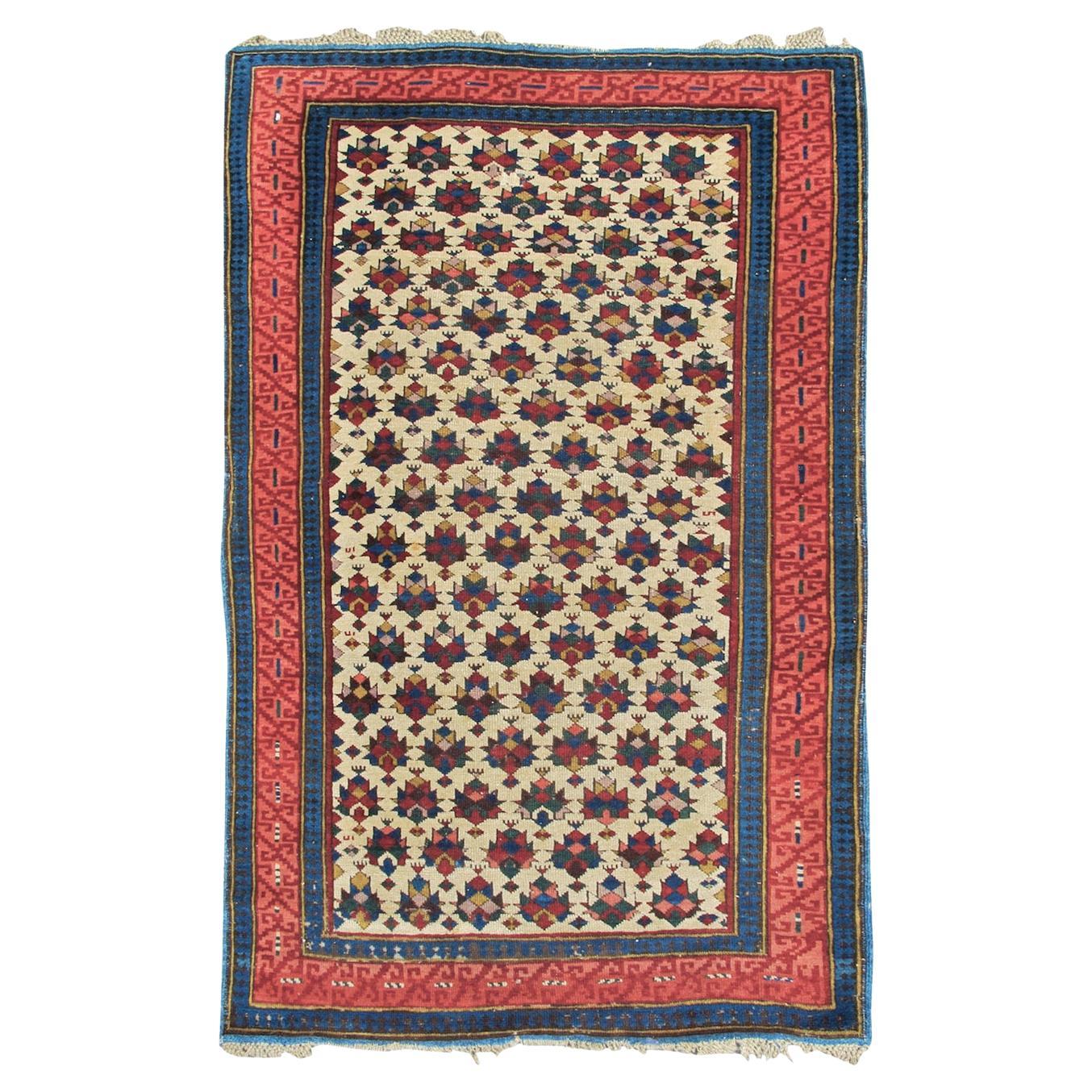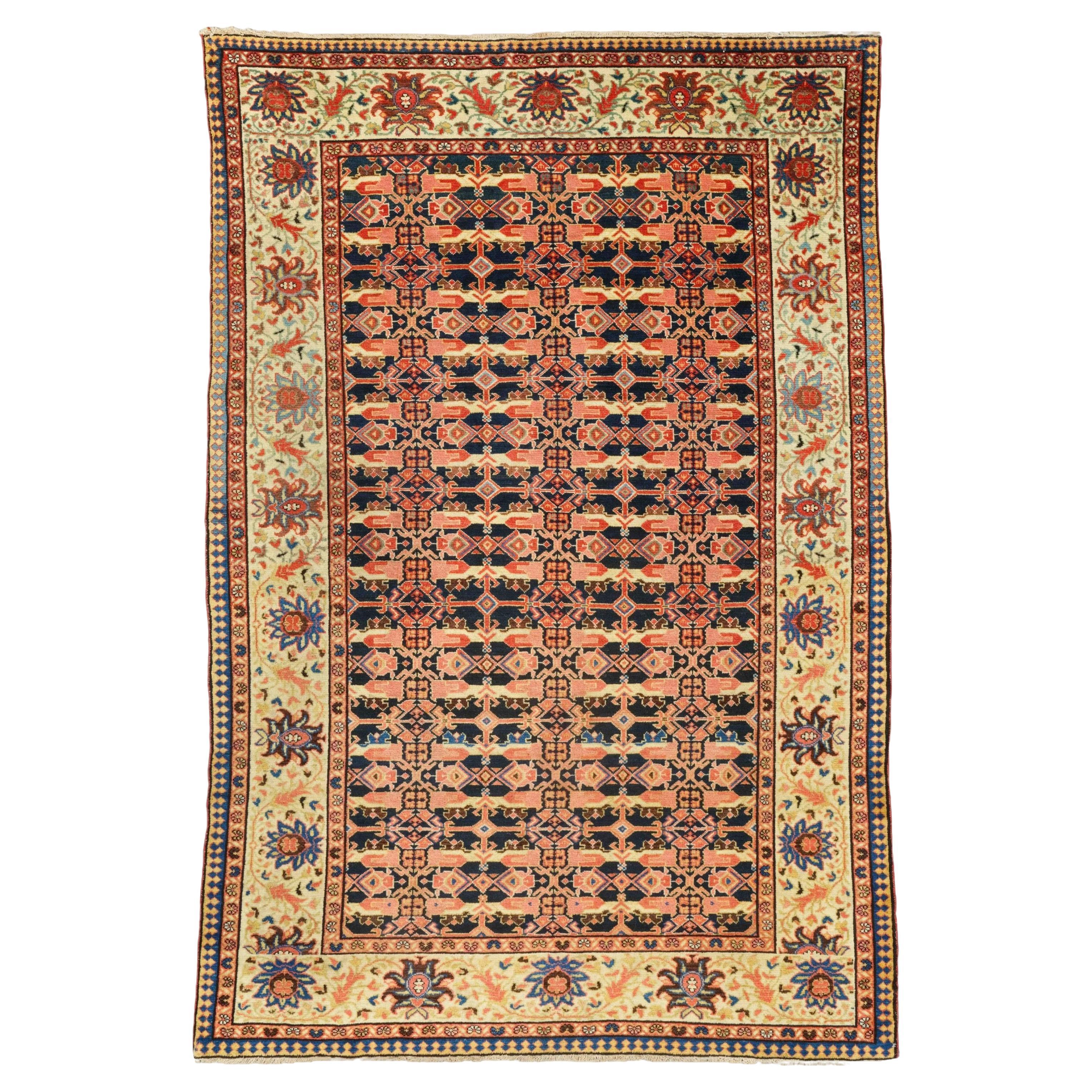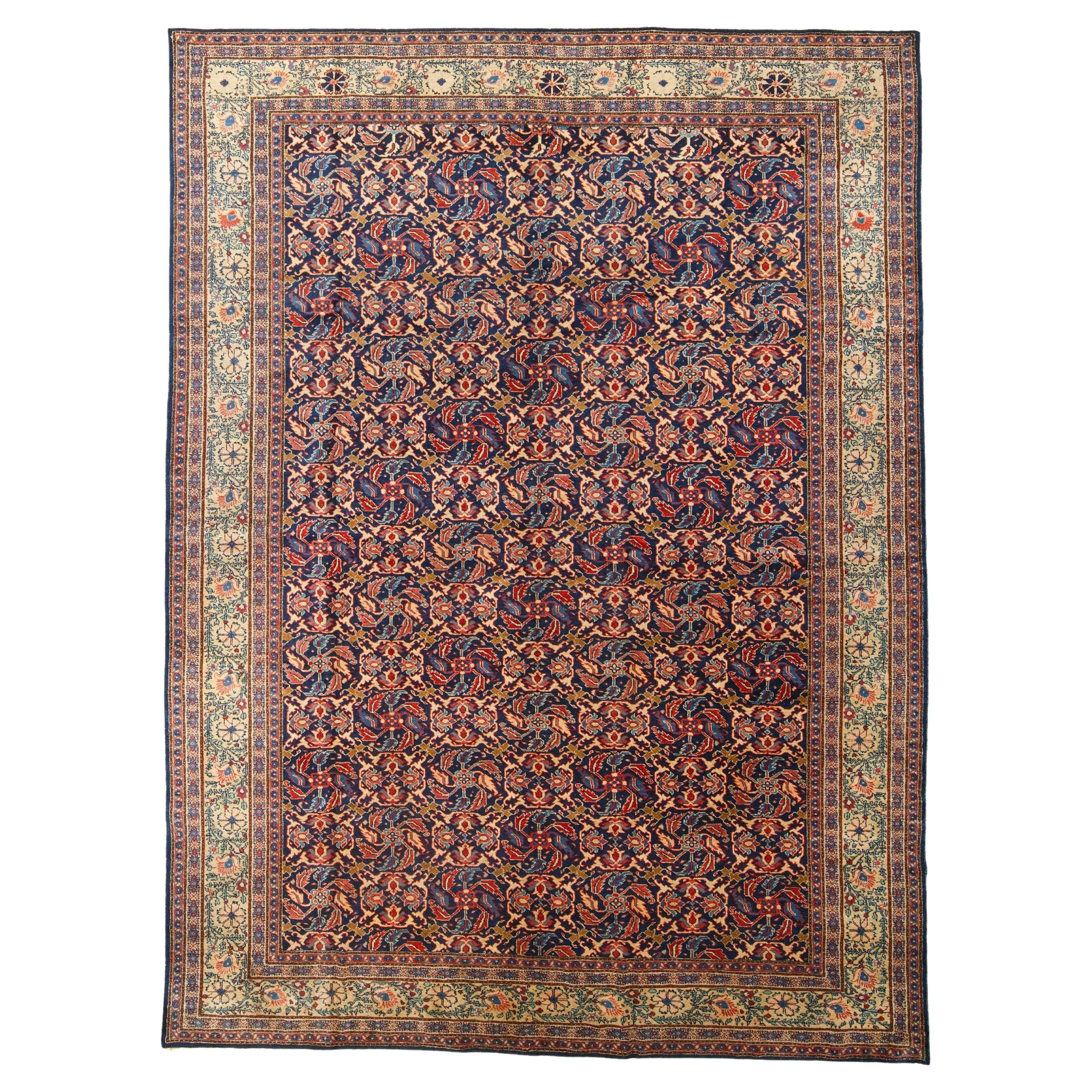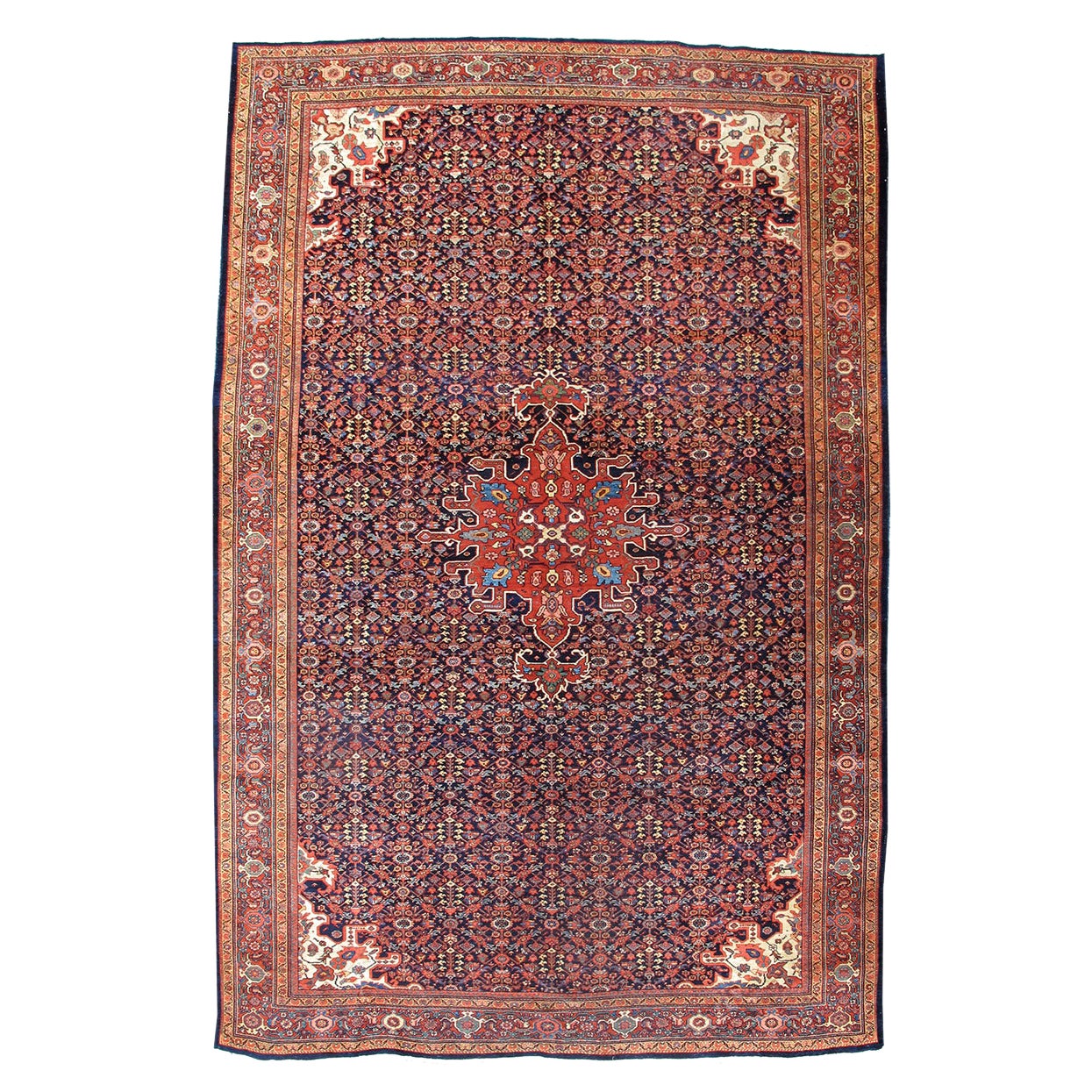Items Similar to Late 3rd Quarter 19th Century Antique Ferahan Sarouk, Glorious Flowers
Want more images or videos?
Request additional images or videos from the seller
1 of 13
Late 3rd Quarter 19th Century Antique Ferahan Sarouk, Glorious Flowers
About the Item
Ferahan Sarouk, 1870 :GLORIOUS FLOWERS
.
From a German collector
Ferahan Sarouk carpets produced around the wider Arak (formerly Sultanabad) area from about 1850-1910 earned a deserved reputation as amongst the most desirable and imaginative finely woven carpets in Persia. As these things go, they morphed in style around 1910- 1920 into the differently woven Mahajirhan Sarouk fashion (quality examples of which are also in demand) and then disappeared entirely.
Their desirability rests not only on fine weaving, and excellent wool. Many of the better examples were commissioned by aristocrats or wealthy merchants who encouraged creativity, in an actively competitive way; rugs during this period, as before, were direct illustrations of an individual’s wealth, power and prestige.
Beyond this lay a more fundamental and seemingly contradictory set of motivations by the weavers. At one and the same time they sought to emulate the great court carpets in finesse and design. And yet-- they applied rustic or village, and even tribal elements and nuances to their designs. The result was a cavalcade of creativity.
So, a village-based genre came into being which produced primarily an approx. 6x4 rug size format, and also provided, if more rarely, larger formats, which command increasingly high prices, due to their rarity, visual excitement and grandeur.
The artistic achievement of this “school” had to do with marrying elegance and a degree of formalism with whimsy, and design innovation. They offer a charm and a certain magic beyond that of court and most city carpets.
As in any area or era, there is a quality spectrum ranging from mediocre to highly superior. Superiority is judged of course as to weave and wool quality. It is rather unusual, though, to encounter pieces made before 1890 -which are bona fide Ferahan Sarouks- with poor wool or weaving: standards were upheld during this period, and natural dyes widely employed, particularly in the wider Arak (then Sultanabad) region.
Thus, as an investment collectible to adorn the home we believe the ultimate criterion is aesthetics, this being an art form, after all.
Ferahan Sarouks have been a special area of interest for us over the decades both from artistic and investment perspectives.
Allowing for personal taste, our suggestions are few and simple. A Ferahan Sarouk ought to display a wide colour palette, fine drawing and delicate, sometimes “intense” detail. The finest pieces also display an elevated sense of balance in the use of space.
We have seen many finely woven pieces which in our view are garish and lack one of the two key artistic elements intrinsic to the better examples of this genre – elegance. Sometimes they are overly cluttered; the drawing artistry is muddled or lost.
In other cases odd and ineffective design devices are used, detracting from or interfering with an otherwise good design. The era of the Ferahan Sarouk was rife with experiment, not all of them successful.
The other important attribute, when it can be found, is original artistic creativity, even serendipity, -- or effective design innovation within the compass of this rug type and the unique standards of its prime period.
On average, we examine between 20-30 antique Ferahan Sarouks to achieve one acquisition, for the benefit of our clients.
With our admitted obsession with Ferahan Sarouks of the highest quality, we were delighted to find this outstanding example recently in a German estate sale.
This piece exhibits numerous attributes which glorify the Ferahan Sarouk genre. First, beautiful, balanced drawing in the overall composition. The corner pieces have innovatively been replaced by flowing vines which are mesmerizing. The artful insertion of colors into the vines, and their abrash coloration corresponding to the medallion reveals a delicacy and attention to detail par excellence .
There is wonderful balance and use of space in this exceptional piece; unlike many otherwise of good quality Ferahan Sarouks its drawing and composition are complex yet uncrowded .
Second, the colour palette is wide as seen in the array of flowers which contrast wonderfully against the dark indigo to near black, delicately abrashed medallion, which please observe. The flowers in the field deserve careful attention for the graceful flowing movement and colour.
The weaving is very fine – this is one of the older Ferahan Sarouks which has the wonderful –and unique among carpets –“leathery” feel or “handle “as said in the trade, owing to the fineness of the weave , and high knot count .
Excellent condition, no repairs. It will last indefinetely in a medium wear environment .
A rug of this calibre is an investment piece as well as work of art which will add quiet joy and dignity to any home.
We acquired this well and are able to make it available at below market rate, and it is subject to a short term introductory discount to coincide with our launch on First Dibs . For a piece of this distinction, age and exceptional design execution a fair market value at " low retail price " is approx 1
- Dimensions:Width: 48 in (121.92 cm)Length: 74 in (187.96 cm)
- Materials and Techniques:Wool,Woven
- Place of Origin:
- Period:
- Date of Manufacture:1870
- Condition:excellent condition, naturally the pile is low but there are no worn spots whatsoever .
- Seller Location:WYNNUM, AU
- Reference Number:
About the Seller
No Reviews Yet
Vetted Seller
These experienced sellers undergo a comprehensive evaluation by our team of in-house experts.
1stDibs seller since 2022
Typical response time: 1 to 2 days
- ShippingRetrieving quote...Ships From: WYNNUM, Australia
- Return PolicyA return for this item may be initiated within 3 days of delivery.
More From This SellerView All
- High Collectible 19th Century Ferahan Sarouk, Princely, at Short Term ReductionLocated in WYNNUM, QLDFerahan Sarouk Museum Quality MUSEUM QUALITY Ferahan Sarouk, third quarter 19th century 6.6 x 4.5 feet From a USA collector Ferahan Sarouk carpets produced around the wider Arak (formerly Sultanabad) area from about 1850-1910 earned a deserved reputation as amongst the most desirable and imaginative finely woven carpets in Persia. As these things go, they morphed in style around 1910- 1920 into the differently woven Mahajirhan Sarouk fashion (quality examples of which are also in demand) and then disappeared entirely. Their desirability rests not only on fine weaving, and excellent wool. Many of the better examples were commissioned by aristocrats or wealthy merchants who encouraged creativity, in an actively competitive way; rugs during this period, as before, were direct illustrations of an individual’s wealth, power and prestige. Beyond this lay a more fundamental and seemingly contradictory set of motivations by the weavers. At one and the same time they sought to emulate the great court carpets in finesse and design. And yet-- they applied rustic or village, and even tribal elements and nuances to their designs. The result was a cavalcade of creativity. So, a village-based genre came into being which produced primarily an approx. 6x4 rug size format, and also provided, if more rarely, larger formats, which command increasingly high prices, due to their rarity, visual excitement and grandeur. The artistic achievement of this “school” had to do with marrying elegance and a degree of formalism with whimsy, and design innovation. They offer a charm and a certain magic beyond that of court and most city carpets. As in any area or era, there is a quality spectrum ranging from mediocre to highly superior. Superiority is judged of course as to weave and wool quality. It is rather unusual, though, to encounter pieces made before 1890 -which are bona fide Ferahan Sarouks- with poor wool or weaving: standards were upheld during this period, and natural dyes were widely employed, particularly in the wider Arak (then Sultanabad) region. Thus, as an investment collectible to adorn the home we believe the ultimate criterion is aesthetics, this being an art form, after all. Ferahan Sarouks have been a special area of interest for us over the decades both from artistic and investment perspectives. Allowing for personal taste, our suggestions are few and simple. A Ferahan Sarouk ought to display a wide colour palette, fine drawing and delicate, sometimes “intense “ detail. The finest pieces also display an elevated sense of balance in the use of space. We have seen many finely woven pieces which in our view are garish and lack one of the two key artistic elements intrinsic to the better examples of this genre – elegance. Sometimes they are overly cluttered; the drawing artistry is muddled or lost. In other cases odd and ineffective design devices are used, detracting from or interfering with an otherwise good design. The era of the Ferahan Sarouk was rife with experiments, not all of them successful. The other important attribute, when it can be found, is original artistic creativity, even serendipity, -- or effective design innovation within the compass of this rug type and the unique standards of its prime period. On average, we examine between 30-40 antique Ferahan Sarouks to achieve one acquisition, for the benefit of our clients. This highly collectible more than 150-year-old carpet is an apex achievement of superior artistry and innovation. As an exemplar of its genre, it can be reasonably described as Museum quality, a term we do not often employ. Please observe the stunning precision of the inner guard and its pinpoint sharp hooks. The elongation of the central medallion is one of its subtle but powerful innovations in form. The nod to asymmetry – which displays a refined sense of humour - is seen in the use of the small diamond figures, as one is deliberately missing from the right hand side: a wry nod to asymmetry, in an otherwise perfectly symmetrical creation. The ultimate achievement here is in the fineness of the weaving itself, on close inspection. The herati pattern in the medallion and corners achieves an etched-on quality, a very uncommon level of attention to detail and perfectionism: clearly the work of a master. This artistic sense extends to the outer ground which is a superb example of the most subtle abrash, one of the most refined we have had the honor of viewing. The unusual beige/brown tones in the field were probably achieved by adding onion skins to the die vat. These extremely fine gradations of colour are rarely seen.(NB the colour photographs create a slightly misleading- overly yellow burnish to the field colour in spite of expert photographic efforts ) . The deliberate choice of an ink black use of indigo provides a powerful frame (border) for this piece of art, which note in the lower right-hand corner is lifted slightly through abrash to a deep blue – to highlight the design and use of emerald green in the rosettes. The green shades lighten as the border ascends harmonizing with the tones in the central medallion. The floating flow of flowers in the border is beautifully executed, with up to seven colours in a single figure. No doubt a piece commissioned by an aristocrat around 1870, it is – remarkably- in virtually perfect condition. It appears to have had very minimal footwear, and great care; a piece which was proudly displayed from time to time and appreciated. Its density and strong foundation would however allow regular use within a home, and in a spacious contemporary home or office could make a wall hanging of striking impact. This remarkable one of a kind piece is on short term reduction to coincide with our launch on 1st Dibs . Fair market value is approximately $22,000 . Fine art as investment ? The WSJ made the following comments this year : The vigor of the art market may seem counterintuitive, but it makes sense in the current environment,” economist Tyler Cowen recently wrote in The Washington Post. “First, many of the wealthy have been buying additional homes and wish to furnish them with art. Second, the recent run-up in inflation rates around the world has intensified the search for hedges.” While the aforementioned artworks fall into traditional categories, some less-prominent forms of fine art also represent ideal investment opportunities, especially because they offer more attractive—i.e., significantly less costly—entry points for new collectors. Take high-collectible and connoisseur-caliber antique Oriental rugs, for example. The best 19th-century examples often sell privately between five figures and low six figures. Today, that obscurity is fading. According to Ben Evans, the editor of Hali Magazine—a publication dedicated to the international rug and textile market—there are two primary factors to explain why antique rugs are beginning to enjoy their moment in the spotlight. “Cultural curiosity and collecting...Category
Antique 1880s Persian Persian Rugs
MaterialsWool
- Impeccable Artistic Antique Ferahan Sarouk, 1880Located in WYNNUM, QLDAcquired from a Swedish collector Ferahan Sarouk carpets produced around the wider Arak (city) area from about 1850-1900 earned a deserved reputation as amongst the most desirable and imaginative finely woven carpets in Persia. As these things go, they morphed in style around 1910- 1920 into the differently woven Mahajirhan Sarouk fashion (quality examples of which are also in demand) and then disappeared entirely. Their desirability rests not only on fine weaving, and excellent wool. Many of the better examples were commissioned by aristocrats or wealthy merchants who encouraged new approaches and creativity, one source of their excellence. Beyond this lay a more fundamental and seemingly contradictory set of motivations by the weavers. At one and the same time they sought to emulate the great court carpets in finesse and design, and yet-- they applied rustic or village, and even tribal elements and nuances to their designs. The result was a cavalcade of creativity. So, a village-based genre came into being which produced primarily an approx. 6x4 rug size format, and also provided, if more rarely, larger formats, which command increasingly high prices, due to their rarity, visual excitement and grandeur. The artistic achievement of this “school” had to do with marrying elegance and a degree of formalism with whimsy, and design innovation. They offer a charm and a certain magic beyond that of court and most city carpets. As in any area or era, there is a quality spectrum ranging from mediocre to highly superior. Superiority is judged of course as to weave and wool quality. It is rather unusual, though, to encounter pieces made before 1890 -which are bona fide Ferahan Sarouks- with poor wool or weaving: standards were upheld during this period, and natural dyes employed universally. Thus, as an investment collectible to adorn the home we believe the ultimate criterion is aesthetics, this being an art form, after all. Ferahan Sarouks have been a special area of interest for us over the decades both from artistic and investment perspectives. Allowing for personal taste, our suggestions are few and simple. A Ferahan Sarouk ought to display a wide colour palette, fine and creative drawing and delicate, sometimes “intense “detail. The finest pieces also display balance in the use of space. We have seen many finely woven pieces which in our view are garish and lack one of the two key artistic elements intrinsic to the better examples of this genre – elegance. Sometimes they are overly cluttered; the drawing artistry is muddled or lost. In other cases odd and ineffective design devices are used, detracting from or interfering with an otherwise good design. The era of the Ferahan Sarouk was rife with experiment, not all of them successful. The other important attribute, when it can be found, is original artistic creativity, even serendipity, -- or effective design innovation within the compass of this rug type and the unique standards of its prime period. On average, we examine between 20-30 antique Ferahan Sarouks...Category
Antique Late 19th Century Persian Persian Rugs
MaterialsWool
- Classic Antique 1870 Ferahan Sarouk -Intense Design VirtuesLocated in WYNNUM, QLDFrom an Australian Collector Ferahan Sarouk carpets produced around the wider Arak (formerly Sultanabad) area from about 1850-1910 earned a deserved re...Category
Antique 1870s Persian Persian Rugs
MaterialsWool
- Aristocratic Ferahan Sarouk 1890 Antique Short Term ReductionLocated in WYNNUM, QLDARISTOCRATIC Ferahan Sarouk 1890 Measures: 6 ft 8 inches x 4 foot 4 inches Ladies, if you seek a gift for your much loved man, to make him feel like...Category
Antique 1890s Persian Persian Rugs
MaterialsWool
- Antique 19th century Afshar , Perfect condition , PlushLocated in WYNNUM, QLDFrom a Boston Collector. Remarkably Creative. This is another of our small stock of Afshar collectibles which astonish as to their artistic form. This example was recently acquired from a Boston collector’s estate. The wool, very soft, is of excellent quality and the weave very fine, the rug in superior condition. Boston Antique carpet expert Michael Grogan declared it as one of the very finest and most original Afshar rugs he had ever seen. This piece was recently used along with two others in a lecture series which pondered the question of likely influence of tribal (and arguably other Persian e,g, Montasham Kashan) rugs on the development of Western 20th century painting. The abrupt break with traditional forms by a gifted female weaver in a remote location and in the throes of a nomadic life, considering her circumstances, is awe inspiring. The wide and in cases unusual colors deployed (note the dark browns probably achieved with walnut shells in the dye vat...Category
Antique 1890s Persian Persian Rugs
MaterialsWool
- Astonishing 19th Century Rare Afshar Tribal rug featured in famous bookLocated in WYNNUM, QLDFeatured as an exemplar of Afshar tribal creativity in James Opie's notable book " Tribal Rugs " this extremely rare collector's piece was used in a lecture series we conducted on the possible albeit unexamined influence of tribal rugs on early 20th century European painting . The Afshars during the 19th century were amongst the dominant five nomadic groups in Iran and unquestionably the most daringly creative, and probably the most prolific in weaving output . Though the vast majority of their carpets exhibit traditional , more angular tribal patterns, this example is an extraordinary tribute to one female weaver as designer . There seems no precedent for the remarkable move into mind bending forms which veer off from the norm , which make it a high collectible and unquestionable investment piece . The achievement of two elements stand out : colour and design execution . The rich and varied natural dye colours are deep and powerful and include a range from the treasured eggplant , through a provocative orange , yellows ( saffron), pale peach, to three unusual blues and a rare rust brown . Green is also sensitively applied to the palette . The design also represents a departure from all norms before or since amongst Afshar rugs . The central medallions have been altered to create an almost moving, slightly hallucinatory effect ; the graceful tumbling of coloured leaves or vines is singular in its presentation, graceful yet very much alive . Most interesting are the designs within the medallion which seem to be an evocation of the ancient Chinese dragon and phoenix symbols . This theory gains a bit more traction when you look at the upright shrine type figure rising up alongside the medallions - these appear Chinese , as well, in a semi- abstract way-- influences such as these had been travelling across thewide continent of Asia for millenia . The borders are classic traditional Afshar , noted for their lovely re-creation of flower symbols , interlinking , and slightly irregular , showing the artistic seredipity of the artist/ weaver . The colours here too, particularly the blues and yellows are nothing short of spectacular . The amount of detailled hand work suggests that this piece would have required at least two years work on a ground loom- a humbling thought in thinking about the nomadic life in the 19th century. This rug is of a size and of such a beauty that in the right open modern decor, it could well occupy a wall space of distinction, as would a modern art canvas...Category
Antique 1880s Persian Persian Rugs
MaterialsWool
You May Also Like
- Kuba Rug, 3rd Quarter 19th CenturyLocated in San Francisco, CAKuba Rug, 3rd Quarter 19th Century Stylized almost crystalline shrubs painted in a rainbow of colors are drawn against the crisp ivory background of this Kuba rug from the Southeast...Category
Antique 19th Century Caucasian Caucasian Rugs
MaterialsWool
- Tekke Main Carpet, 3rd Quarter 19th CenturyLocated in San Francisco, CATekke Main Carpet, 19th Century Additional Information: Dimensions: 6'4" W x 9'0" LCategory
Antique 19th Century Turkmen Turkish Rugs
MaterialsWool
- Oversized Antique Persian Ferahan Sarouk Coral and Blue Rug, late 19th CenturyLocated in Hudson, NYA late 19th Century Ferahan Sarouk a with coral field color and beautiful shades pinks, greens and indigo and navy blue. Delicate floral motifs with meandering vines. A very finely w...Category
Antique 1890s Persian Persian Rugs
MaterialsWool
- Antique Persian Ferahan Rug - Late 19th Century Ferahan Rug, Persian RugLocated in Sultanahmet, 34Antique Ferahan Rug Late 19th Century Ferahan Rug in Perfect Condition Size 135 x 200 cm (53,1x78,7 In) This elegant late 19th century antique Ferahan carpet will increase the elega...Category
Antique Late 19th Century Asian Persian Rugs
MaterialsWool
- Antique Ferahan Rug - Late 19th Century Ferahan Carpet in Good ConditionLocated in Sultanahmet, 34Antique Ferahan Carpet - Late 19th Century Ferahan Carpet in Good Condition 260 x 344cm (8,53 x 11,28 ft) Ferahan carpets are usually made with the asymmetrical knot on a cotton fou...Category
Antique 19th Century Azerbaijani Persian Rugs
MaterialsWool
- Antique Fereghan Sarouk Rug, Late 19th CenturyLocated in San Francisco, CAAntique Persian Fereghan Sarouk Rug, Late 19th Century Central pendant medallion on a midnight blue field with gul Hannae pattern within a madder palmette and vine border. Addition...Category
Antique Late 19th Century Persian Persian Rugs
MaterialsWool
Recently Viewed
View AllMore Ways To Browse
Century Furniture Of Distinction Furniture
Century Furniture Of Distinction
Antique Labled Furniture For Sale
Used Retail Display Furniture
Antique Magic
Odd Antique
Antique Flower Charm
Retail Display Case Used
Trade Key
First Dibs
Antique Retail Case
Good Taste In Fashion
Flower Charm Black
Antique Retail Display
Antique Retail Displays
Retail Display Case
Antique Whimsy
Antique Old Fashioned Bedroom





